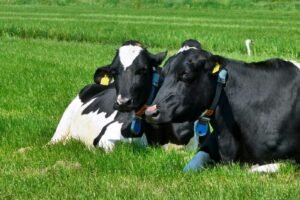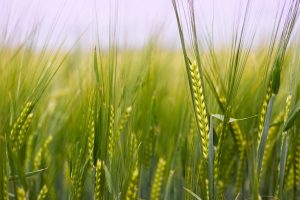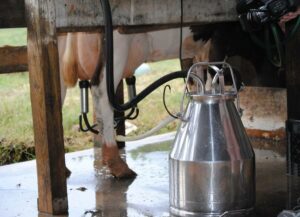Fernando Díaz
The raising demand for butterfat in the US along with higher milk fat price has increased the usage of fat supplements enriched (80 – 98%) with palmitic acid in the dairy industry. Recent studies have shown that feeding palmitic acid to lactating cows increases milk fat production. In postpartum cows; however, feeding supplemental fats may depress feed intake, affect body reserves, and increase the risk of metabolic disorders.
Researchers from Michigan State University evaluated the effects of feeding palmitic acid on production responses and energy partitioning of 52 early-lactation cows. During the fresh period (0 – 24 days in milk) cows were separated in two groups and received a fresh diet either with or without palmitic acid. Posteriorly, during the peak period (25 – 67 days in milk) cows were separated again in two feeding groups and fed a peak diet with or without supplemental palmitic. The fresh diets were higher in protein (17.5 vs. 16.8% in a dry matter basis; DM) and lower in starch (23.5 vs. 25.5% DM) than the peak diets.
The palmitic supplement was added into the diets at 1.5% DM so on average, cows received daily 333 and 450 g of supplement during the fresh and peak period, respectively. Total fatty acid concentrations in the fresh diets without and with palmitic were 3.0 and 4.5%, respectively. Similarly, fatty acid content in the peak diets were 3.5 and 5.1%.
The results of this study were published recently in Journal of Dairy Science (2019), and in summary, the authors de Souza and Lock reported the following findings:
- Feeding palmitic acid during the fresh period (0 – 24 days in milk) did not affect intake nor milk yield (22.2 and 47.9 kg/day, respectively). However, cows receiving palmitic produced more energy-corrected-milk (ECM; 56.6 vs. 51.9 kg/day), milk fat (2.29 vs. 2.01 kg/day), and milk protein (1.60 vs. 1.50 kg/day) than cows that did not received the supplemental fatty acid. At the same time, supplemented cows lost more body weigh (2.65 vs. 1.89 kg/day) and body condition score during this period and had higher levels of nonesterified fatty acids (NEFA) in plasma (0.65 vs. 059 mmol/L). Therefore, the greater performance observed in cows fed palmitic may be due to a higher adipose tissue mobilization.
- During the peak period (25 – 67 days), regardless of the diet cows received in the fresh period, feeding palmitic increased milk yield (58.0 vs. 54.6 kg/day), ECM production (61.5 vs. 56.9 kg/day), and milk fat yield (2.27 vs. 2.06 kg/day) without affecting DM intake (average: 30 kg/day). Interestingly, the authors observed that feeding palmitic during the peak period increased milk fat yield to a greater extent in cows that did not receive the fat supplement during the fresh period (2.31 vs. 2.23 kg/day).
- In addition, cows that received palmitic during the fresh period had lower body weight (675 vs. 695 kg) and lost more body reserves (0.28 vs. 0.18 kg/day) during the peak period than cows that were fed the unsupplemented diet.
In conclusion, feeding palmitic acid to fresh cows increases mobilization of body reserves and NEFA concentration in plasma. Therefore, this practice is not recommended during the postpartum period.
References
- de Souza, J., and A. L. Lock. 2019. Effects of timing of palmitic acid supplementation on production responses of early-lactation dairy cows. J. Dairy Sci. 102:260–273.
- de Souza, J., C. Strieder-Barboza, G. A. Contreras, and A. L. Lock. 2019. Effects of timing of palmitic acid supplementation during early lactation on nutrient digestibility, energy balance, and metabolism of dairy cows. J. Dairy Sci. 102:274–287.









